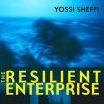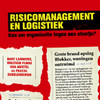 One of the blogs I like to browse from time to time, particularly when looking for topics related to resilience and business, is the Enterprise Resilience Management Blog. Written by Stephen F. DeAngelis, a technologist who creates businesses at the intersection of technology and major business and global trends, I like it because he takes bits and pieces from a variety of online, i.e. Internet sources and produces extensively long posts, a skill I have yet to learn as far as this blog goes. Every now and then, actually more than now and then recently, the blog has posts on supply chain issues and today I stumbled upon a June 2010 post on supply chain risk management, where he explains how cost-cutting can be the supply chain’s worst enemy. This is the first time I have spent some considerable time on DeAngelis’ blog, and it is not going to be the last time.
One of the blogs I like to browse from time to time, particularly when looking for topics related to resilience and business, is the Enterprise Resilience Management Blog. Written by Stephen F. DeAngelis, a technologist who creates businesses at the intersection of technology and major business and global trends, I like it because he takes bits and pieces from a variety of online, i.e. Internet sources and produces extensively long posts, a skill I have yet to learn as far as this blog goes. Every now and then, actually more than now and then recently, the blog has posts on supply chain issues and today I stumbled upon a June 2010 post on supply chain risk management, where he explains how cost-cutting can be the supply chain’s worst enemy. This is the first time I have spent some considerable time on DeAngelis’ blog, and it is not going to be the last time.
Supply chain or supply costs?
The article highlights that the supply chain is a company’s secret weapon in avoiding supply chain disruption costs, and while streamlining and leaning operations do look good in the operating budget, lean for some may be a risky way to take. Quoting from my most recent discovery, Zurich’s Supply Chain Risk Insights, DeAngelis writes
“For a supply chain strategy to provide competitive advantage, companies need to understand and manage the disruption risk,” says David Martin, head of customer and distribution management for Zurich Financial Services’s global corporate division, based in Zurich. “If they don’t, a strategy designed to ensure sustainable profits may actually make them less resilient.”
Obviously, cutting risks and cutting costs are two strategies that are often detrimental to each other, and after cutting costs simply for the sake of reducing operational costs, you may have to cut corners in order to cut risks, because there’s no money left where money was supposed to be for investing in mitigating supply chain risks.
Supply Chain Trend: Risk Management
Given DeAngelis’ solid professional background there are quite a number of good posts on his blog that relate to supply chain risk. In a more recent post he discusses the latest supply chain management trends, as mentioned in The Five Challenges of Today’s Global Supply Chains on SCDigest, where one of the emerging trends is risk management:
Risk Management Involves the End-to-End Supply Chain: Risk and opportunity management should span the entire supply chain—from demand planning to expansion of manufacturing capacity—and should include the supply chains of key partners.
It is true. A supply chain is not some logistics that is added on to the core business. In many cases it is the core business, and ought to be treated as such, end-to-end.
More supply chain risk
Other interesting finds in “supply chain risk” on the Enterprise Resilience Management Blog is a post on Traceable Supply Chains and Food Safety, discussing how RFID is the coming new technology here. Unsurprisingly, the infamous volcanic ash cloud has left its mark on many supply chain blogs this Spring, my blog included, and DeAngelis is perhaps right when in A Kick in the Ash for Supply Chains he thinks that after the Ericsson-Nokia fire incident 10 years ago, now the volcanic ash cloud will perhaps be the next textbook example of supply chain disruptions and how to develop future business continuity plans.
Memories…
This is not the first time I have used a post from the Enterprise Resilience Management Blog. Back in In December 2007 I wrote a post on how we need to think the unthinkable, quoting from a post on complexity and resilience, which discussed how infrastructure networks are complex, vulnerable, and critical to a country’s economy. That was at the very beginning of this blog, and I was still struggling with finding content, and when I was at the very verge of where I decided to become a regular blogger in supply chain risk research and literature. It is interesting to see that the Enterprise Resilience Management Blog still uses TypePad, the same platform I was using at that time, although I have since switched to WordPress. It is good to see that the very crude and basic TypePad layout still persists, clearly indicating that content is king on that blog, as it should be on mine, perhaps?
Link
- enterpriseresilienceblog.typepad.com: Supply Chain Risk Management
Related
- husdal.com: Supply Chain (Risk) blogs of note
- husdal.com: Business Continuity blogs of note












